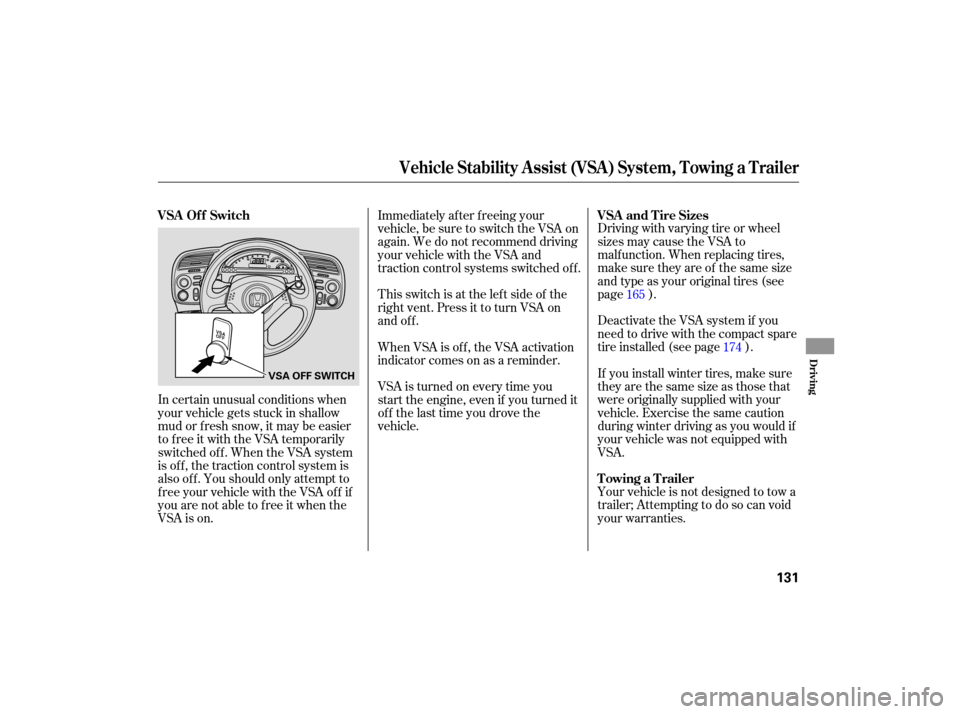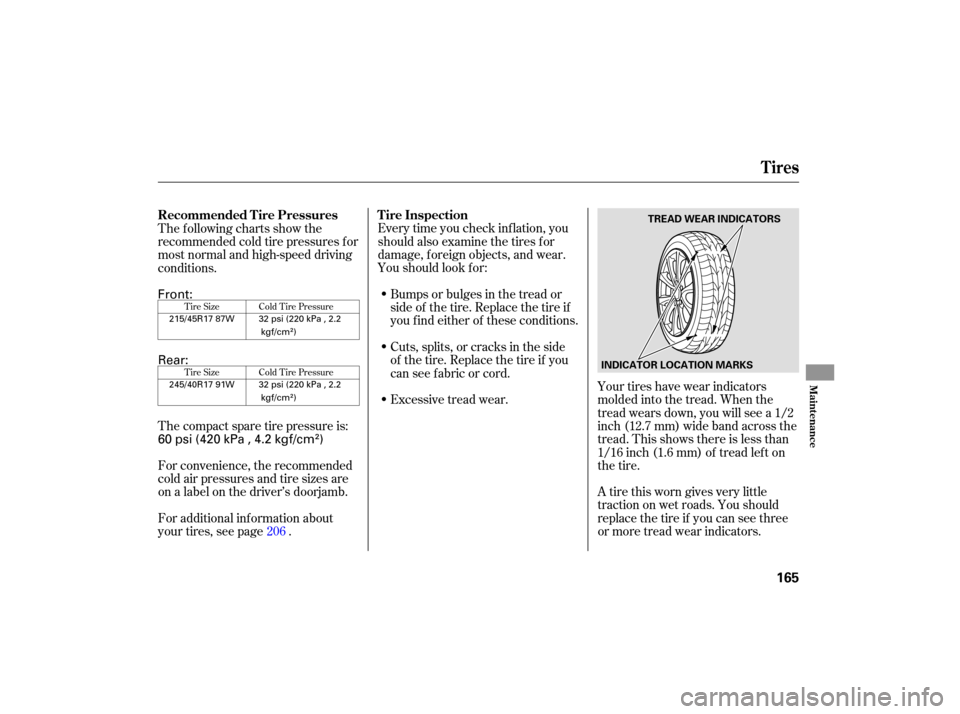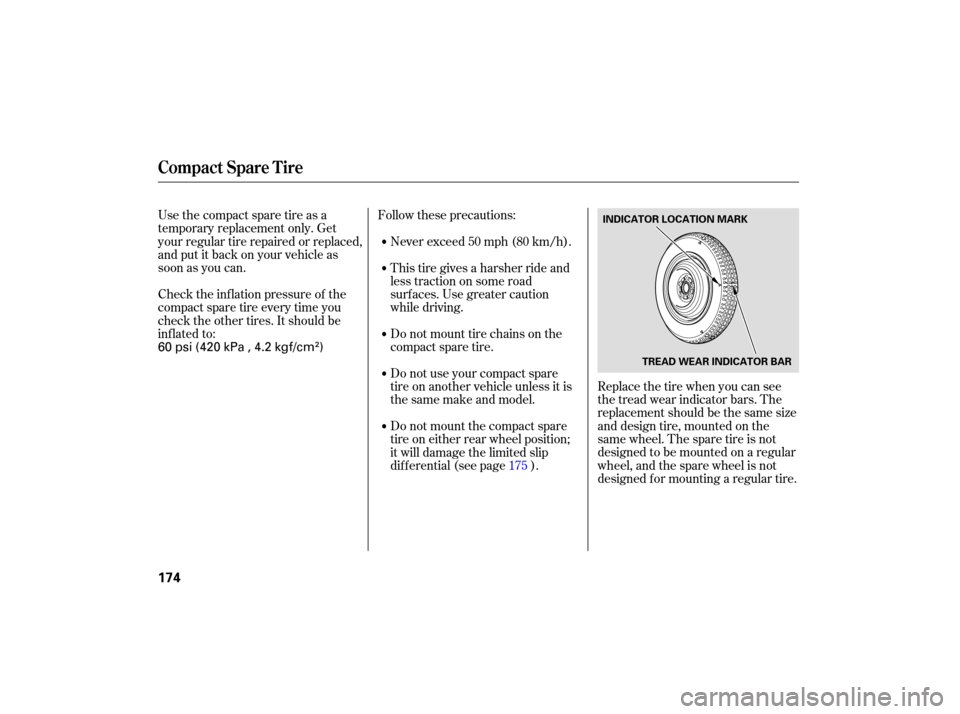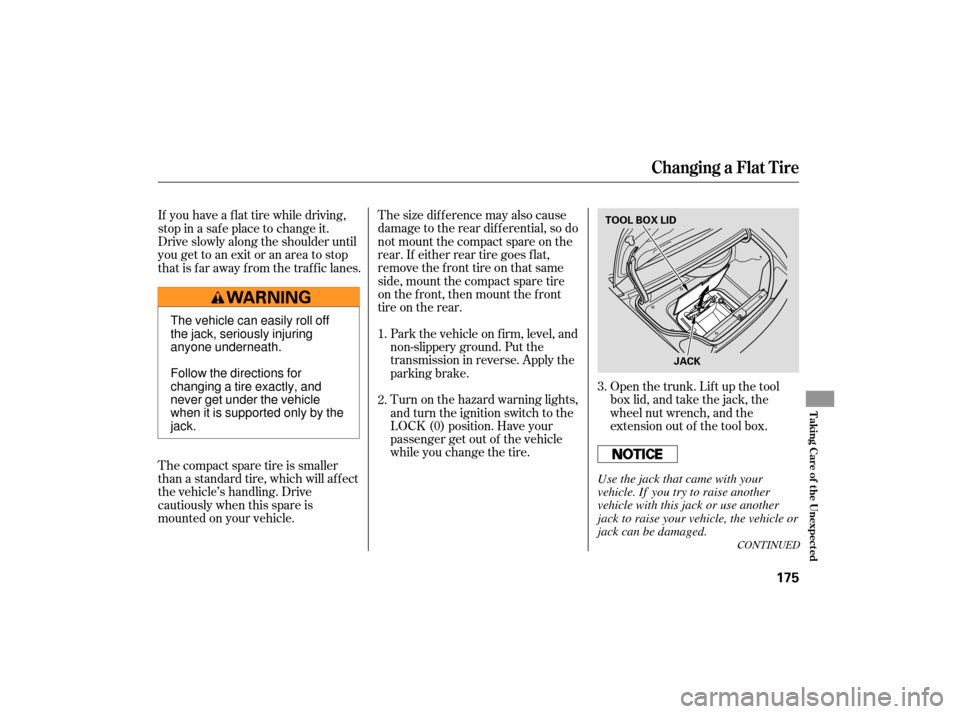Page 134 of 228

Your vehicle is not designed to tow a
trailer; Attempting to do so can void
your warranties.
Driving
with varying tire or wheel
sizes may cause the VSA to
malfunction. When replacing tires,
make sure they are of the same size
and type as your original tires (see
page ).
Deactivate the VSA system if you
need to drive with the compact spare
tire installed (see page ).
If you install winter tires, make sure
they are the same size as those that
were originally supplied with your
vehicle. Exercise the same caution
during winter driving as you would if
your vehicle was not equipped with
VSA.
In certain unusual conditions when
your vehicle gets stuck in shallow
mud or f resh snow, it may be easier
to free it with the VSA temporarily
switched of f . When the VSA system
is of f , the traction control system is
alsooff.Youshouldonlyattemptto
f ree your vehicle with the VSA of f if
you are not able to f ree it when the
VSA is on. Immediately af ter f reeing your
vehicle, be sure to switch the VSA on
again. We do not recommend driving
your vehicle with the VSA and
traction control systems switched off.
When VSA is off, the VSA activation
indicator comes on as a reminder. This switch is at the lef t side of the
right vent. Press it to turn VSA on
and off.
VSA is turned on every time you
start the engine, even if you turned it
off the last time you drove the
vehicle.
165
174
VSA Of f Switch
Towing a Trailer VSA and Tire Sizes
Vehicle Stability Assist (VSA) System, Towing a Trailer
Driving
131
VSA OFF SWITCH
Page 167 of 228

Keeping the tires properly inflated
provides the best combination of
handling, tread life, and riding
comfort.
Underinflated tires wear unevenly,
adversely affect handling and fuel
economy, and are more likely to
fail from being overheated.
Overinflated tires can make your
vehicleridemoreharshly,are
more prone to damage from road
hazards, and wear unevenly.
We recommend that you visually
check your tires every day. If you
think a tire might be low, check it
immediately with a tire gauge. Use
a gauge to measure the air
pressure in each tire at least once a
month. Even tires that are in good
condition may lose 1 to 2 psi (10 to
20 kPa, 0.1 to 0.2 kgf/cm ) per
month. Remember to check the
sparetireatthesametime.
Check the air pressures when the
tires are cold. This means the
vehicle has been parked for at least 3
hours, or driven less than 1 mile (1.6
km). Add or release air, if needed, to
match the recommended cold tire
pressures on page . If you check air pressures when the
tires are hot [driven f or several miles
(kilometers)], you will see readings 4
to6psi(30to40kPa,0.3to0.4
kgf /cm ) higher than the cold
readings. This is normal. Do not let
air out to match the recommended
cold air pressure. The tire will be
underinf lated.
Youshoulduseyourowntire
pressure gauge and use it whenever
you check your tire pressures. This
will make it easier f or you to tell if a
pressure loss is due to a tire problem
and not due to a variation between
gauges.
While tubeless tires have some
ability to self -seal if they are
punctured, you should look closely
f or punctures if a tire starts losing
pressure.
165
Inf lation Guidelines
Tires
164
Page 168 of 228

Bumps or bulges in the tread or
side of the tire. Replace the tire if
youfindeitheroftheseconditions.
Cu ts, splits, or cracks in the side
of the tire. Replace the tire if you
can see fabric or cord.
Excessive tread wear.
A tire this worn gives very little
traction on wet roads. You should
replace the tire if you can see three
or more tread wear indicators.
Every
time you check inflation, you
should also examine the tires for
damage, foreign objects, and wear.
Youshouldlookfor:
Thecompactsparetirepressureis:
For convenience, the recommended
cold air pressures and tire sizes are
on a label on the driver’s doorjamb.
For additional inf ormation about
your tires, see page . The following charts show the
recommended cold tire pressures f or
most normal and high-speed driving
conditions.
Your tires have wear indicators
molded into the tread. When the
tread wears down, you will see a 1/2
inch (12.7 mm) wide band across the
tread. This shows there is less than
1/16 inch (1.6 mm) of tread lef t on
the tire.
206Tire Size Cold Tire Pressure
Tire Size Cold Tire Pressure
Tire Inspection
Recommended Tire Pressures
Tires
Maint enance
165
INDICATOR LOCATION MARKS TREAD WEAR INDICATORS
Front:
Rear:
60 psi (420 kPa , 4.2 kgf/cm
)
215/45R17 87W 32 psi (220 kPa , 2.2
kgf/cm
)
32 psi (220 kPa , 2.2 kgf/cm
)
245/40R17 91W
Page 176 of 228

This section covers the more
common problems that motorists
experience with their vehicles. It
gives you inf ormation about how to
safely evaluate the problem and what
to do to correct it. If the problem has
stranded you on the side of the road,
you may be able to get going again.
If not, you will also f ind instructions
on getting your vehicle towed.......................
Compact Spare Tire .174
....................
Changing a Flat Tire .175
.............
If the Engine Won’t Start . 180
................................
Jump Starting .182
..............
If the Engine Overheats . 183
.........
Low Oil Pressure Indicator . 186
..........
Charging System Indicator . 186
.......
Malf unction Indicator Lamp . 187
...............
Brake System Indicator . 188
.......
Closing the Convertible Top . 189
..............................................
Fuses .190
..........
Checking and Replacing . 191
..............................
Fuse Locations .194
......................
Emergency Towing .196
..........
If Your Vehicle Gets Stuck . 196
Taking Care of the Unexpected
T aking Care of t he Unexpect ed
173
Page 177 of 228

Use the compact spare tire as a
temporary replacement only. Get
your regular tire repaired or replaced,
and put it back on your vehicle as
soon as you can. Follow
these precautions:
Replace the tire when you can see
the tread wear indica tor bars. The
replacement should be the same size
and design tire, mounted on the
samewheel.Thesparetireisnot
designed to be mounted on a regular
wheel, and the spare wheel is not
designed for mounting a regular tire.
Check
the inflation pressure of the
compact spare tire every time you
check the other tires. It should be
inflated to: Never
exceed 50 mph (80 km/h).
This tire gives a harsher ride and
less traction on some road
surfaces. Use greater caution
while driving.
Do not mount tire chains on the
compact spare tire.
Do not use your compact spare
tire on another vehicle unless it is
thesamemakeandmodel.
Do not mount the compact spare
tire on either rear wheel position;
it will damage the limited slip
dif f erential (see page ). 175
Compact Spare Tire
174
INDICATOR LOCATION MARK
TREAD WEAR INDICATOR BAR
60 psi (420 kPa , 4.2 kgf/cm)
Page 178 of 228

Thesizedifferencemayalsocause
damage to the rear dif f erential, so do
not mount the compact spare on the
rear. If either rear tire goes f lat,
remove the f ront tire on that same
side, mount the compact spare tire
on the f ront, then mount the f ront
tire on the rear.Park the vehicle on f irm, level, and
non-slippery ground. Put the
transmission in reverse. Apply the
parking brake.
Turn on the hazard warning lights,
and turn the ignition switch to the
LOCK (0) position. Have your
passenger get out of the vehicle
while you change the tire. Open the trunk. Lift up the tool
box lid, and take the jack, the
wheel nut wrench, and the
extension out of the tool box.
Thecompactsparetireissmaller
than a standard tire, which will affect
the vehicle’s handling. Drive
cautiously when this spare is
mounted on your vehicle. If you have a f lat tire while driving,
stop in a saf e place to change it.
Drive slowly along the shoulder until
you get to an exit or an area to stop
that is far away from the traffic lanes.
3.
1.
2.
CONT INUED
Changing a Flat Tire
T aking Care of t he Unexpect ed
175
TOOL BOX LID
JACK
The vehicle can easily roll off
the jack, seriously injuring
anyone underneath.
Follow the directions for
changing a tire exactly, and
never get under the vehicle
when it is supported only by the
jack. Use the jack that came with your
vehicle. If you try to raise another
vehicle with this jack or use another
jack to raise your vehicle, the vehicle or
jack can be damaged.
Page 179 of 228
Unscrew the wing bolt, and take
the spare tire out of the spare tire
shelf .
Remove the three clips holding
the spare tire cover by pulling the
rings straight back. Remove the
sparetirecover.
Loosen each wheel nut 1/2 turn
with the wheel nut wrench.Place the jack under the jacking
point nearest the tire you need to
change. Turn the end bracket
clockwise until the top of the jack
contacts the jacking point. Make
sure the center of the jacking
point tab is resting in the jack
notch.
4.
5.
6. 7.
Changing a Flat Tire
176
SPARETIRECOVER
WHEEL NUT WRENCH
JACKING
POINT
CLIPS
Page 180 of 228
Use the extension and the wheel
nut wrench as shown to raise the
vehicle until the f lat tire is of f the
ground.Bef ore mounting the spare tire,
wipeanydirtoff themounting
surface of the wheel and hub with
a clean cloth. Wipe the hub
carefully;itmaybehotfrom
driving.
Remove the wheel nuts, then
removetheflattire.Handlethe
wheel nuts caref ully; they may be
hot from driving. Place the flat tire
on the ground with the outside
surface facing up.
8.
9.10.
CONT INUED
Changing a Flat Tire
T aking Care of t he Unexpect ed
177
BRAKE HUB
EXTENSION